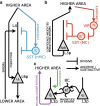Confidence and second-order errors in cortical circuits
- PMID: 39346625
- PMCID: PMC11437657
- DOI: 10.1093/pnasnexus/pgae404
Confidence and second-order errors in cortical circuits
Erratum in
-
Correction to: Confidence and second-order errors in cortical circuits.PNAS Nexus. 2025 Jul 21;4(7):pgaf217. doi: 10.1093/pnasnexus/pgaf217. eCollection 2025 Jul. PNAS Nexus. 2025. PMID: 40692542 Free PMC article.
Abstract
Minimization of cortical prediction errors has been considered a key computational goal of the cerebral cortex underlying perception, action, and learning. However, it is still unclear how the cortex should form and use information about uncertainty in this process. Here, we formally derive neural dynamics that minimize prediction errors under the assumption that cortical areas must not only predict the activity in other areas and sensory streams but also jointly project their confidence (inverse expected uncertainty) in their predictions. In the resulting neuronal dynamics, the integration of bottom-up and top-down cortical streams is dynamically modulated based on confidence in accordance with the Bayesian principle. Moreover, the theory predicts the existence of cortical second-order errors, comparing confidence and actual performance. These errors are propagated through the cortical hierarchy alongside classical prediction errors and are used to learn the weights of synapses responsible for formulating confidence. We propose a detailed mapping of the theory to cortical circuitry, discuss entailed functional interpretations, and provide potential directions for experimental work.
Keywords: cortical computation; energy-based models; predictive coding; uncertainty.
© The Author(s) 2024. Published by Oxford University Press on behalf of National Academy of Sciences.
Figures





References
-
- Walker EY, et al. 2023. Studying the neural representations of uncertainty. Nat Neurosci. 26(11):1857–1867. - PubMed
-
- Ernst MO, Banks MS. 2002. Humans integrate visual and haptic information in a statistically optimal fashion. Nature. 415(6870):429–433. - PubMed
-
- Olkkonen M, McCarthy PF, Allred SR. 2014. The central tendency bias in color perception: effects of internal and external noise. J Vis. 14(11):5–5. - PubMed

